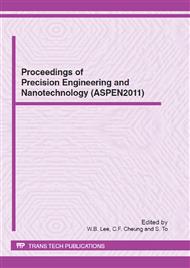p.305
p.311
p.317
p.321
p.326
p.332
p.337
p.343
p.349
Development of Novel Polishing System by Use of Acoustic Trap
Abstract:
Based on the acoustic levitation phenomenon, we have proposed and developed an acoustic levitation/trap system to control the movements of free abrasives for the finishing of inner surfaces. Described in this paper are the theoretical analysis of levitation force generated in a standing wave field, and experimental results of levitation and trap. A simulation is first performed to determine the wave amplitude and frequency required to levitate the actual abrasives. Based on those results, we developed a system which consists of a sound transducer (speaker), a reflector (an aluminium plate), an amplifier and a function generator, and successfully not only levitated but also trapped actual abrasives in a cylindrical tube. It is found that the relation between the size, density of the abrasives and the power of the acoustic field (wave amplitude and frequency) fairly agreed with the theoretical prediction. Also, the kinetics of levitated abrasives including their positions and movements are precisely controllable by varying the wave frequency and switching from one node position to another.
Info:
Periodical:
Pages:
326-331
Citation:
Online since:
June 2012
Authors:
Price:
Сopyright:
© 2012 Trans Tech Publications Ltd. All Rights Reserved
Share:
Citation:


